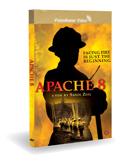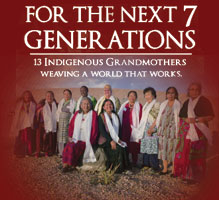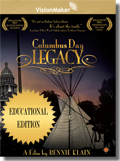Lincoln, Neb: Eleven production contracts from Native American Public Telecommunications, Inc. (NAPT) have been approved for the delivery of documentary and new media projects to the Public Broadcasting System.
“The purpose of this funding is to increase the diversity of voices available to PBS viewers,” says NAPT Executive Director Shirley K. Sneve (Rosebud Sioux). “We encourage Native Americans to take on significant creative leadership roles, such as director, producer and editor. We want Native voices to have creative control, and not just in an advisory capacity.”
Funding for the projects comes from the Corporation for Public Broadcasting.
The eleven films recommended for funding include:
Across the Creek
Producer: Jon Cournoyer (Rosebud Sioux)
Broken by the legacy of colonialism, the Lakota Tribes struggle for restoration, healing and rebuilding. This film focuses on mostly the elder generation and their reflections on the youth, specifically to family structure, spirituality and language to help reclaim their stories, values and visions for the future.
Apache Scouts: An Untold Story
Producers: Velma Craig (Diné) and Dustinn Craig (White Mountain Apache/Navajo)
The U.S. Army had little to no success subduing Apache bands of the Southwest, until White Mountain Apaches enlisted as Army Scouts. This film explores the complex histories of the Scouts, their relation to Geronimo and to securing the White Mountain Apache homeland.
Finding Refuge
Producers: Torsten Kjellstand, Rob Finch, Jamie Francis, and Isabella Blatchford (Supiaq/Alutiiq, Inupiaq)
The efforts of one dying woman to preserve her Native culture don’t end when she passes, but prompts a renewal in finding pride in that culture. She confronts the violent event over two centuries ago that began the destruction of her people and the shame that colonialism created.
Kivalina People
Producer: Gina Abatemarco
This film is an intimate and unique look into the public and private lives of one of America’s last Indigenous cultures trying to survive in the modern Arctic, where struggles of poverty, climate change, and culture are inextricably intertwined.
The Mayor of Shiprock
Producer: Ramona Emerson (Diné)
In the town of Shiprock, N.M., the harsh realities of Reservation life and the beautiful, reddened landscape of the rock formations build stories of survival and existence. Poverty and corruption have long been a struggle in the community and as the Navajo Nation looks for leadership, it is met with scandal. To make a change, a young group of men and women are taking back their community—led by 21-year-old Graham Beyale. This is the story of how one will make a difference and inspire a generation of leaders to make changes in their own communities.
Ohiyesa: The Soul of an Indian
Producers: Sydney Beane (Flandreau Santee Sioux) and John Whitehead
This documentary follows Kate Beane, a young Dakota women, as she examines the extraordinary life of her celebrated relative, Charles Eastman (Ohiyesa). Biography and journey come together as Kate traces Eastman’s path—from traditional Dakota boyhood, through education at Dartmouth College, and in later roles as physician, author, lecturer, and Native American advocate.
Rising Voices/Hothaninpi
Producer: Wilhelm Meya
This is the story of five young Lakotas who are on a journey to learn their language—representing a new generation transforming their world in the 21st century. Five short films by Lakota filmmakers will be integrated into 90-minute anchor film. Also, regional Native American filmmakers partnered with PBS stations will develop additional short films about each region’s Native American language.
Spirit in Glass
Producer: Penny Phillips
A celebration of Native American Plateau art and culture, the film emphasizes the origin and remarkable survival of the art form and culture as experienced by Native Plateau bead artists.
Yellow Fever
Producer: Sophie Rousmaniere
Tina Garnanez, a young Navajo woman, begins a personal investigation into the history of the Navajo Uranium Boom, examining its lasting impacts and the potential for new mining in the area. Looking at the cost of cheap energy and the future of the industry, Tina becomes an advocate, lobbyist, and a vocal proponent for environmental justice.
Young Lakota
Producers: Marion Lipschutz, Rose Rosenblatt, and Heather Rae (Cherokee)
This series of five short videos features leaders addressing Native American women’s health. It is an online complement to the documentary Young Lakota to be broadcast on “Independent Lens” in 2013. Distributed electronically, the videos are particularly relevant to the contemporary experience of young people, girls and women in Indian Country. Funds will be used for community engagement.
We Breathe Again
Producer: Evon Peter (Neetsaii Gwich’in)
One of the most difficult and tragic issues Alaska Native communities face today is suicide—with a rate six times the national average. This feature-length documentary is the story of four Alaska Natives wrestling with the impacts of suicide and illuminating a path towards healing.
About NAPT
Native American Public Telecommunications, Inc. (NAPT), a nonprofit 501(c)(3) which receives major funding from the Corporation for Public Broadcasting, shares Native stories with the world through support of the creation, promotion and distribution of Native media. Founded in 1977, through various media—Public Television, Public Radio and the Internet—NAPT brings awareness of Indian and Alaska Native issues. NAPT operates VisionMaker, the premier source for quality Native American educational and home videos. All aspects of our programs encourage the involvement of young people to learn more about careers in the media—to be the next generation of storytellers. NAPT is located at the University of Nebraska-Lincoln. NAPT offers student employment, internships and fellowships. Reaching the general public and the global market is the ultimate goal for the dissemination of Native-produced media.
Download the Press Release: Word | PDF
Please email NAPT Marketing Director, Jessica Kinser, at [email protected] if you would like a high-quality version of an image pictured below.
| ACROSS THE CREEK |
|
|
|
 |
Producer Jon Cournoyer (Rosebud Sioux). Image courtesy of Joe Pugliese Photography. |
|
|
| |
|
|
|
| FINDING REFUGE |
|
|
|
 |
Producer Torsten Kjellstrand. Image courtesy of Torsten Kjellstrand LLC. |
 |
Co-producer Rob Finch. Image courtesy of Torsten Kjellstrand LLC. |
 |
Co-producer Jamie Francis. Image courtesy of Torsten Kjellstrand LLC. |
 |
Co-producer Isabella Blatchford (Supiaq/Alutiiq, Inupiaq). Image courtesy of Torsten Kjellstrand LLC. |
 |
Image still from FINDING REFUGE. Image courtesy of Torsten Kjellstrand LLC. |
 |
Image still from FINDING REFUGE. Image courtesy of Torsten Kjellstrand LLC. |
| |
|
|
|
| KIVALINA PEOPLE |
|
|
|
 |
Producer Gina Abatemarco. Image courtesy of Gina Abatemarco.
|
 |
Image still from KIVALINA PEOPLE. Image courtesy of Gina Abatemarco.
|
| |
|
|
|
| THE MAYOR OF SHIPROCK |
|
|
|
 |
Producer Ramona Emerson (Diné). Image courtesy of Reel Indian Pictures.
|
 |
Image still from THE MAYOR OF SHIPROCK. Image courtesy of Reel Indian Pictures.
|
| |
|
|
|
| OHIYESA: THE SOUL OF AN INDIAN |
|
|
|
 |
Producer Sydney Beane (Flandreau Santee Sioux). Image courtesy of Dakota Eastman Production.
|
 |
Co-producer John Whitehead. Image courtesy of Dakota Eastman Production. |
| |
|
|
|
| SPIRIT IN GLASS |
|
|
|
 |
Producer Penny Phillips. Image courtesy of Mimbres Fever Productions.
|
 |
Image still from SPIRIT IN GLASS. Image courtesy of Mimbres Fever Productions. |


 The study reports results of American Indian and Alaska Native students grades 4 and 8 on the National Assessment of Educational Progress (NAEP), as well as the results of a special survey of American Indian and Alaska Native students, their teachers, and their school administrators—focusing on Native language and culture related to the education of American Indian and Alaska Native students.
The study reports results of American Indian and Alaska Native students grades 4 and 8 on the National Assessment of Educational Progress (NAEP), as well as the results of a special survey of American Indian and Alaska Native students, their teachers, and their school administrators—focusing on Native language and culture related to the education of American Indian and Alaska Native students.














 In an article by Matt Goodlett of Omaha, Neb.'s The Reader, the question is raised of "What is Uranium Mining in Nebraska Doing to Pine Ridge's Drinking Water?"
In an article by Matt Goodlett of Omaha, Neb.'s The Reader, the question is raised of "What is Uranium Mining in Nebraska Doing to Pine Ridge's Drinking Water?"
